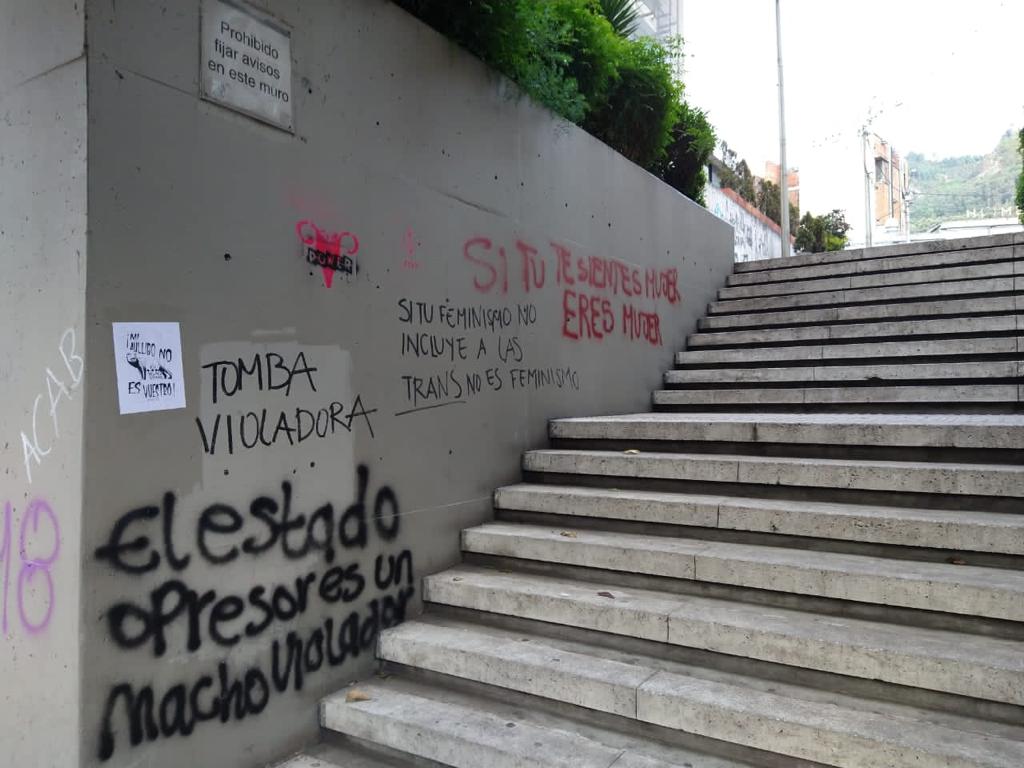
A street vendor in Bogotá being asked to move by police.
Faye Griffiths highlights the flawed reasoning behind the city’s new administration forcing street vendors to move on
When a friend was back in town over the holidays, we met for lunch at Crepes & Waffles. As it was hitting record temperatures that week, we wanted to sit on the terrace. The staff told us we couldn’t due to possible changes to public space laws. Shocking, in a middle class problem sort of way.
That was the first change regarding public space I’d heard about, but there were soon more to follow, and sadly, they seem to have more far-reaching effects than spoiling wealthy women’s lunch dates.
Since January, the Bogotá City Council, under the new mayor’s guidance, has been implementing plans to remove street vendors from key parts of the city, particularly around Avenida Chile and the Séptima.
The current administration argues that Bogotá needs to “recover” its public spaces. Often described as a visionary by the Colombian press, Mayor Peñalosa has said that he sees public space as an area where rich and poor should meet as equals, yet one of his first moves seems to have had a negative impact on a vulnerable section of society.
What exactly is meant by public space? Occupation of it and the potential recovery of it, are all open to somewhat differing definitions. I feel that, as with any complex issue such as who has the right to use public space, it is very easy to reduce the debate to a simple maxim, such as ‘we need to reclaim or recover public space’, without actually considering, why and for whom, and with what consequences.
And maybe I’m being cynical, but the subtext seems to be that vendors are undesired in the areas where business people, tourists, and gentlefolk stroll around, which is a serious paradox from someone who claims to support social integration.

Our girl Faye with Amparo and Flor, two of the vendors she spoke with.
At one time, perhaps no more than two or three generations ago, a lot more business was conducted in public spaces and a lot more food and general shopping was done outside too, before the development of supermarkets and shopping centres. My grandfather worked on the fish market in Shudehill, Manchester, and the town where I grew up had a thriving open air market, so I suppose I have a sort of interest or affinity for this kind of street business.
But of course the world is becoming (for good reason) more concerned with health and safety, and for better or worse, more formalised. There are issues regarding street vending which clearly need to be addressed, such as health and safety, taxation, extortion etc, but it saddens me to see just how quickly the Colombian press has stepped in to help create negative images of street vendors.
I buy from various street stalls on a daily basis (partly because I hate queuing in supermarkets) and I have spoken to quite a few vendors over the past months. To me, the large majority of those who work selling their wares – from scrambled eggs prepared at the side of the road to mini mobile newsagents – are honest working people who feel their livelihood is under threat from the new city administration.
As Amparo, a juice vendor in Parkway said, “It seems like he wants us all to become thieves. If you can’t make a living, people will go to that.”
So why exactly does Peñalosa want the vendedores ambulantes to amble on?
Flor, originally from Chocó but now living in Suba thinks it’s because “Peñalosa doesn’t like us”. She sells bin bags and says it can’t be a question of taking up space since she carries what she sells with her.
But is the new policy being dictated simply be personal distaste?
Saturation point?
In a pre-election interview in October with El Tiempo, Peñalosa raised the idea that public space is being taken up more with each passing day by private vendors.
It’s not that this isn’t true, and it could well be that Bogotá is reaching saturation point, but what he neglected to discuss in this interview is why there are so many people engaged in the informal economy in Bogotá and Colombia in general.
All of the vendors I have spoken to are involved in that line of work because they don’t have viable alternatives to make a living. There simply isn’t a lot of dignified employment for people with no formal training or education. Normally, a neo-liberal politician like Peñalosa would applaud their get up-and-go attitude, but perhaps the desire for quick and superficial indicators of improvement overrides this.

There are also all sorts of other street vendors, selling anything from sunglasses to avocados through to fruit and natural juices.
Crime and disorder
Peñalosa also argues that, “In developing-world cities vendors bring disorder and thus a fertile environment for crime.”
This comes from an article he wrote for The Rockefeller Institute a few years ago, in which he goes on to say that they “act as an illness which debilitates the area, and makes it lose value and become dangerous”.
It seems to me that proving a connection between ordered public spaces and safety is based on flawed reasoning.
The countries that have fewer street vendors are often more economically stable with less poverty and less inequality and therefore less crime. The high numbers of people working outside the formal economy are emblematic of the country’s lack of welfare provision and access to employment more than anything else.
And I don’t think it’s true to say that the street vendors mask illegal practices or prevent the police from doing their jobs, which has been claimed in the media. I’ve seen them actively cooperating with the police many times.
Certainly, as a woman walking alone, I feel safer when walking down certain streets which are busy with street sellers because it is reassuring to see familiar faces, especially when many are also women.
Just walk on by – but where to?
On February 28, thousands of people took to the streets in various parts of the city to march against the changes. They called for a democratic use of public space, claiming that the city has not honoured its promises to find alternative employment for the displaced vendors.
At the same time, one vendor has just successfully taken her case to court. The court ordered that she be guaranteed a return to her trading position after she claimed the administration had to protect her right to work by relocating her.
The battle for the city’s public space is being fought on the streets and in the courts, and the coming months will be key.
Peñalosa may well believe that his ruling is making the city better. But he doesn’t seem to understand – or care – why the streets are so occupied. He wants to impose order and control on things that are tangible evidence of the deeply entrenched inequalities in Bogotá life, yet at the same time is suspending the social programmes which could, over time, remedy those problems.
On Saturday I walked down the Avenida Chile, normally bursting with street activity, and it was eerily quiet and empty. The issue of street vending is so integral to so many livelihoods that I really doubt that the practice will just fade out quietly. I for one hope that it doesn’t.





